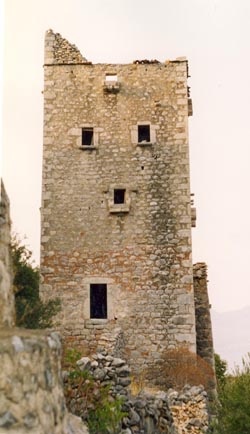 |
|
 A Brief History of the Balteas Family from Stavropigi of Exo Mani and Messinia, to Varousi in Lakonia* By Aris Poulimenakos, genealogist, and Nikos Balteas Foreward by Donald George McPhail, Editor of Mani: Yesterday, Today, Tomorrow Translation and notes by Mary Papoutsy, publisher of HCS. *The original article appeared in Greek in the May-June issue (Volume 10) of the magazine Mani: Yesterday, Today, Tomorrow. Posted to HCS with permission of the editor. |
|
|
The surname Balteas we encounter today only in a very small number of families. The ancestral place of all these families in Mani is the village Stavropigi, which was formerly called Varousi and belonged to Lakonia until 1938. Since that time it has become part of Messinia. It is now, in other words, a village of what is called Messinian Mani. I, the widow of Giorgakis Anastaseas am selling the house plot that I got from Frilingeas . . . . according to the estimate which Markeas and Balteas render and I hereby certify the above through this testimony.
Fig. 1 In this document of 1807 we find the surname Balteas identical to the one today. 1807 nevertheless is a [year in a] relatively small record period during which the old Maniot suffix for surnames changes in large numbers from "-akis" to "-eas." Compare with the following record of 1809 (Fig. 2), likewise a record of sale: With my presence, I myself testify, stasinos yianeas, together with my wife, [that] I made an exchange with Mr. Dimitrakis Koutoufareas . . . . and we have remained pleased for two days, hereby signing 1809 September 17 Giorgakis Baltakis, signed and witnessed.3 1Notations in brackets throughout the article represent elaborations added by the translator to aid readers. Items enclosed in parentheses are those of the authors. 2The English translation omits some details of the description of the plot. 3Once again, the English translation omits details of the property. |
|
|
|

